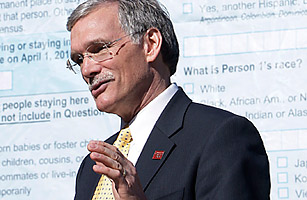
America is aging. Americans are living longer but having fewer children, and the country’s population growth can be largely attributed to immigration, much of it Hispanic. We’ve known this for a while — earlier reports have estimated that whites would become a minority in the U.S. by the year 2050 — but exactly how, where and at what rate these changes are happening has largely been a matter of conjecture.
On May 26, the U.S. Census bureau released two reports. One is an extensive study of the Hispanic population while the other details the slowing down of the U.S. population growth rate. The U.S. has a new median age of 37 years, up from 35 in 2000 and 33 in 1990.
The aging nation “isn’t a surprise,” says U.S. Census director Robert Groves, who sat down with TIME for an exclusive discussion of the reports. “It’s happening throughout the world in developed societies,” not just the U.S., but this is the first report to detail the changes based on last year’s national census. As of 2010, most baby boomers have moved beyond the childbearing period of their lives; as they age so does the country. In fact, the brief showed that there are seven states in the U.S. with a median age over 40. At nearly 42 years old, Maine is the oldest state. Utah is the youngest, coming in at a spry 29.
Why the discrepancy? “Utah has on average very large households,” Groves explains. The number of children per household in Utah is “exceptionally large,” he says, coming in at 3.1 people — almost an entire person more than Maine’s households. Yes, this preference for multi-child homes can be largely attributed to Utah’s Mormon culture, but the state draws many young non-Mormons as well. “Some states simply attract young people with more jobs,” says Groves. Utah has been economically strong in recent years, with a wave of job creation in the mid-2000s that helped it weather the 2008 recession better than other areas of the country. Meanwhile, Maine falls into the category of “states that appeal to older people looking to retire,” says Groves. “Oregon is one too.”
A second U.S. Census report focused on the Hispanic population, which at 50.5 million has grown 43% over the past 10 years. That’s four times faster than the general U.S. population and more than 40 times faster than non-Hispanic whites, who grew by a measly 1%. In certain areas of the country — namely the Northeast and the Midwest, where many states experienced stunted or nonexistent population expansion — the Hispanic population sometimes rose as much as 12 times faster than the state’s population overall.
Such rapid growth may have helped keep the U.S. looking younger than it would have otherwise. In 2009, the Census Bureau reported that the median age for the Hispanic population was just under 26. As the rest of the country continues to age, the expansion of the youthful Hispanic population will help offset the rest of the nation’s demographic shift.
Counting an ethnic group that contains a significant number of undocumented or illegal workers is no easy task, of course. But ever since the first census in 1790, the U.S. has made a point to count every single person living within the nation’s borders, regardless of status. Groves says his 2010 Census team worked “neighborhood by neighborhood, with community groups that [undocumented workers] trusted.” He won’t know the extent of his success or failure until next year, when bureau’s self-evaluations of its methods are officially released.
Some of the Census’ findings shed light on what we already know: towns and cities near the U.S.-Mexican border have a significantly higher than average percentage of Hispanic residents for example, and in fact, half of the U.S. Hispanic population lives in just three states: California, Texas and Florida.
But Groves points out that these areas aren’t the only parts of the country affected by this Hispanic population boom. There are small pockets of immigrants peppered all over the country, especially in rural areas. Even the suburbs are seeing an influx of minority and immigrant residents. “We’re actually at the beginning of a transition,” says Groves. “In the next ten years, we will go through an amazing, interesting, fascinating change of cultures rubbing up against each other.” When the Census Bureau knocks on our doors in 2020 , Groves expects to find a much more diverse, and perhaps less racially and ethnically isolated, nation than the one we live in today.
So is the famed American melting pot melting even more? “Well, it’s definitely a pot,” says Groves. “Whether it melts or not, we’ll have to see.”
Should the Census Be Asking People if They Are Negro?
See TIME’s Pictures of the Week.